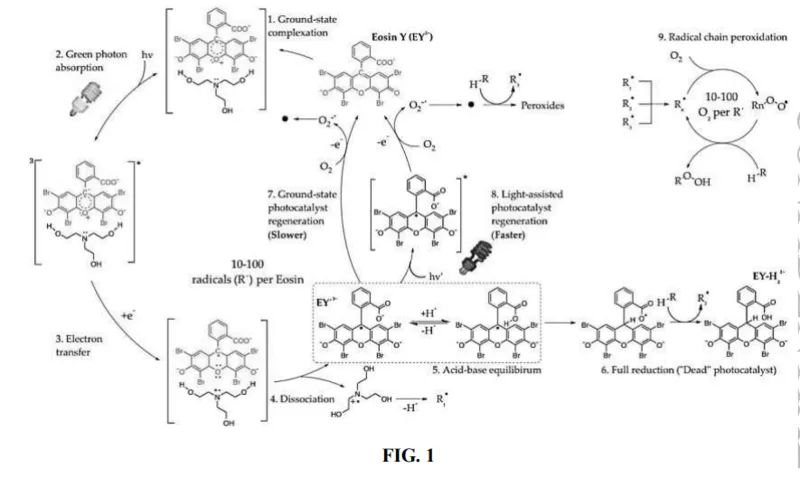Photoexcitation of Intermediates to Accelerate Photocatalyst Regeneration and Increase its Efficiency
A novel photocatalyst to counter oxygen inhibition in the polymerization and crosslinking reactions initiated by radicals could be used in the synthesis of hydrogels in biomedicine, where oxygen must always be present.
Researchers
-
light-assisted photocatalyst regeneration and oxygen-resilient radical polymerization
United States of America | Granted | 11,351,530
Figures
Technology
This invention comprises a photocatalyst, Eosin Y, which acts aqueously during the radical polymerization of hydrogel precursor polyethylene glycol dicacrylate (PEGDA) to confer resilience to oxygen inhibition. In general, photocatalysts are substances that absorb light to increase the speed of a reaction and are able to regenerate anew for each round of reactions. Eosin Y, in particular, interacts with triethanolamine (TEOA) in a reaction cycle that is driven by two separate wavelengths of light applied at two different times during the reaction cycle. These wavelengths ensure a higher rate of catalyst regeneration and thus reduce Eosin Y “death,” or inhibition, over multiple cycles. In each reaction cycle, Eosin Y interacts with oxygen molecules to prevent them from inhibiting the polymerization of PEGDA. This mechanism, as well as the optimum wavelengths for photocatalysis, were verified with spectroscopic data. Based on these data, hundreds of O2 molecules are consumed per photon absorbed.
Problem Addressed
Polymerization and crosslinking reactions are widely used in the synthesis of hydrogels in biomedicine. However, oxygen present in physiological conditions inhibits these reactions by oxidizing the reagents. A novel regenerating photocatalyst that could react with oxygen upon photostimulation would prevent oxygen from inhibiting the reaction in such a manner.
Advantages
- Novel photocatalyst used in the synthesis of hydrogels for biomedical purposes
- Increased efficiency of photocatalyst regeneration by two particular wavelengths of light
- Reduction of oxygen inhibition in hydrogel formation
Publications
Kaastrup, K., et al. (2016). UV-Vis/FT-NIR in situ monitoring of visible-light induced polymerization of PEGDA hydrogels initiated by eosin/triethanolamine/O2. Polymer Chemistry, 7, 592-602. doi: 10.1039/C5PY01528F.
Wong, J., Kaastrup, K., Aguirre-Soto, A., & Sikes, H. D. (2015). A quantitative analysis of peroxy-mediated cyclic regeneration of eosin under oxygen-rich photopolymerization conditions. Polymer, 69, 169-177. doi: 10.1016/j.polymer.2015.05.043.
License this technology
Interested in this technology? Connect with our experienced licensing team to initiate the process.
Sign up for technology updates
Sign up now to receive the latest updates on cutting-edge technologies and innovations.
